Communicating Code over Conference Calls
In this guide, we'll pick up some tips and tricks on how to communicate code better over conference calls, such as how to increase the zoom level of any application (Tip #3).
-
Tip #1: Increase the Font Size Everywhere (with instructions; yes, I did the Googling for you)
-
Tip #2: Use Live Share (Google Docs, but for coding)
-
Tip #3: Global Zoom using macOS Accessibility / Microsoft ZoomIt
-
Tip #5: Display an Agenda List on Screen
-
Tip #6: Have an Audience Take Notes
Background
Software engineers generally were able to work from home during the Covid-19 pandemic. While many have enjoyed the flexibility that comes with being able to work from home, it is not without its own sets of disadvantages.
One such problem: effective communication of code over conference calls.
What you see:
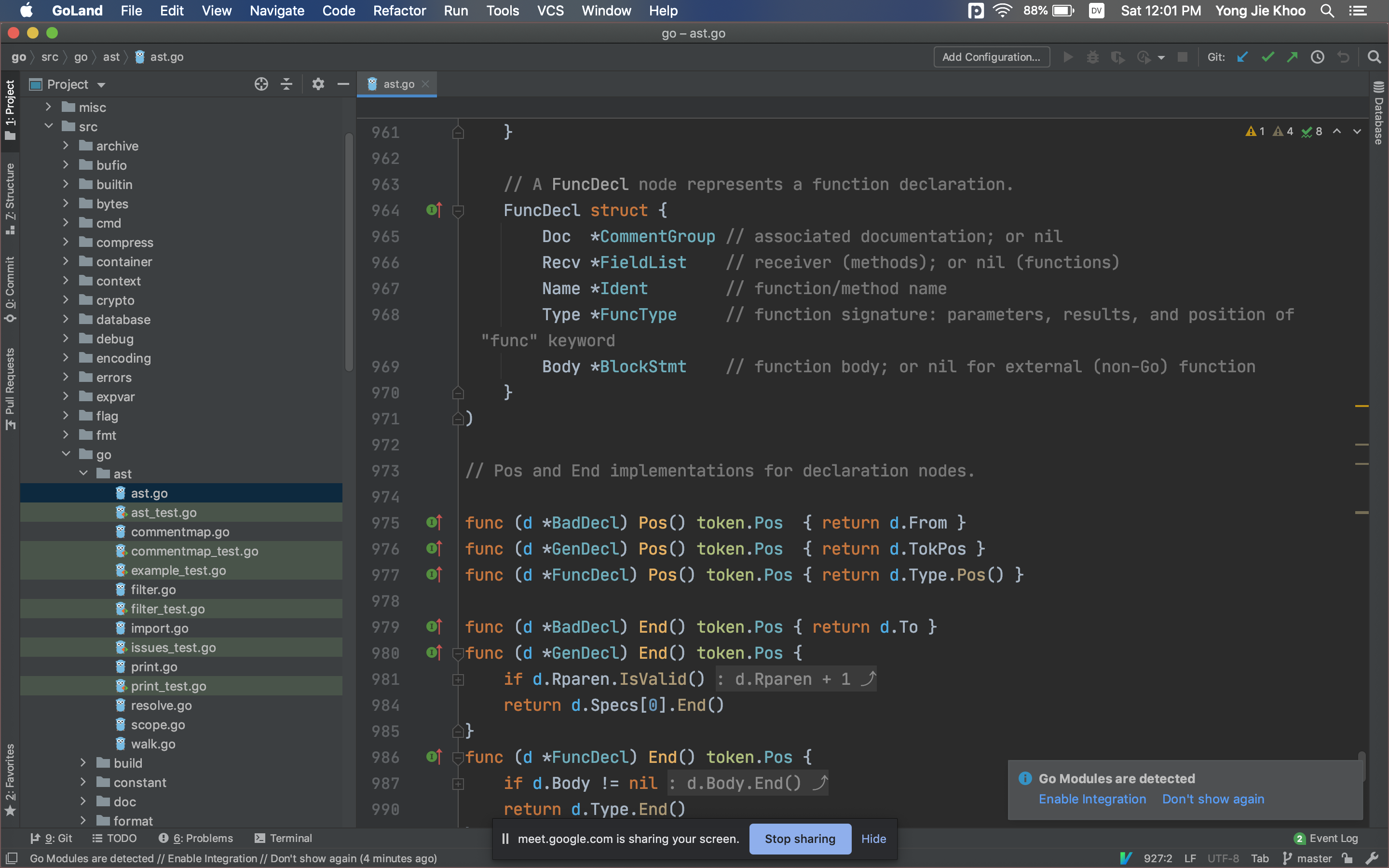
vs what they see (notice how the comments are especially hard to
read because of the compression artefacts):
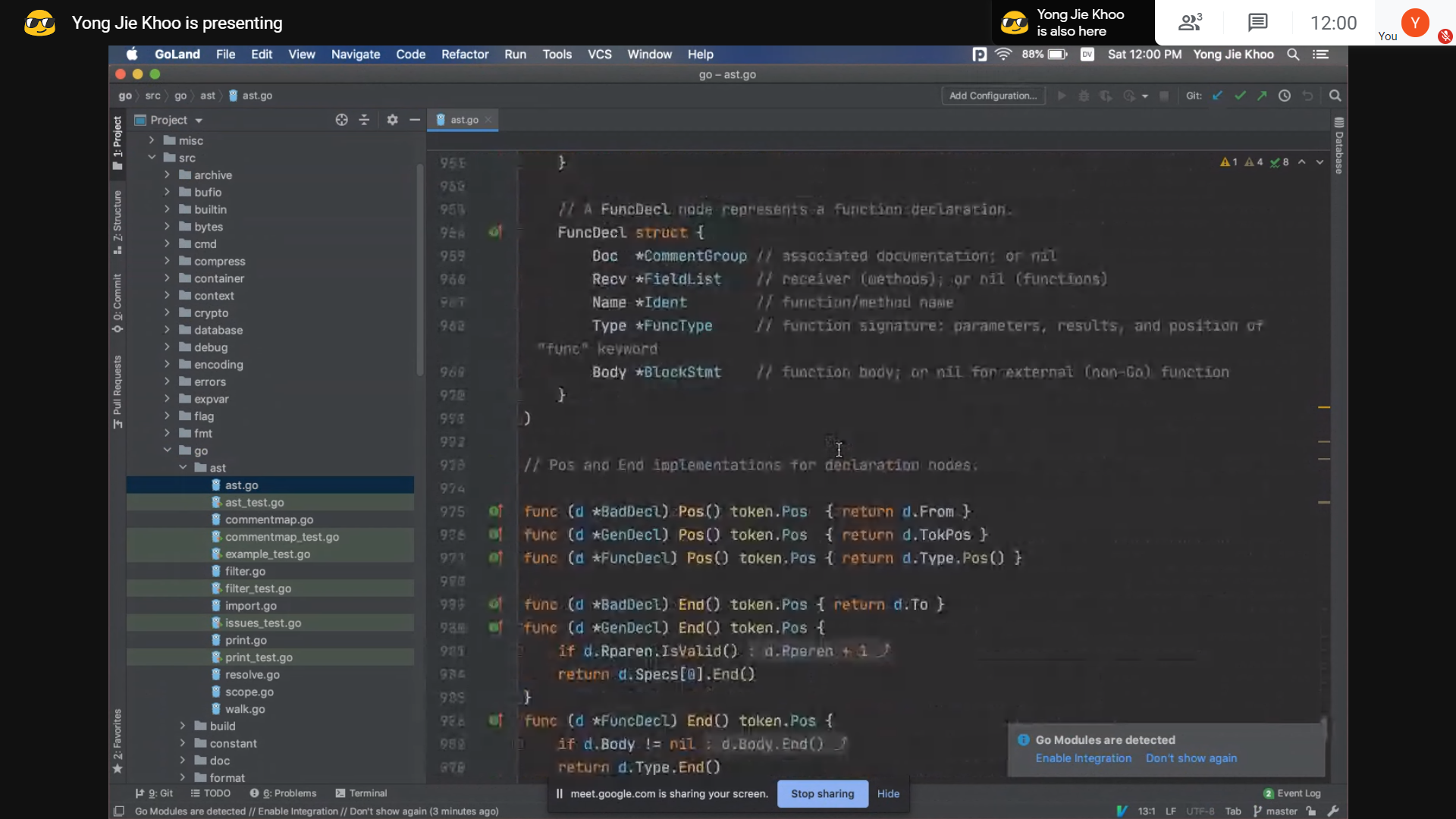
Deciphering code in and or itself already requires mental effort, to make matters worst, when communicating over conference calls, we face more issues:
-
As an audience:
-
Poor video quality due to compression.
-
Choppy connection and not being able to follow when the presentor moves around the code.
-
-
As the presenter:
-
We also face the issue of not knowing exactly whether the participants are following along fine.
-
Tip 1: Increase the Font Size Everywhere
This point is more subtle than you might imagine—as a presenter, you might have already switched to a font size larger than usual, and the code might look sufficiently zoomed in for you, however, what the participants see might be a low quality compression version of the code.
As such, it is crucial to know how to quickly change the font size, and respond to any such request from the audience.
(In the examples below, replace <Control> with <Command> on macOS).
-
Visual Studio Code:
-
<Control> + =to zoom in -
<Control> + -to zoom out -
<Control> + 0to reset zoom
-
-
IntelliJ Idea / GoLand
-
Enable zooming in/out using mouse wheel:
-
Go to
Preferences>Editor>General -
Ensure
Change font size with Command+Mouse Wheelis enabled
-
-
Enable soft-wrapping so long lings are wrapped after zooming in:
-
Go to
Preferences>Editor>General -
Ensure
Soft-wrap these files:is checked, and add the relevant wildcards to wrap the various file types (e.g.,*.java)
-
-
For those keyboard-inclined users, unfortunately IntelliJ Idea doesn't has any preset keyboard shortcuts for changing zoom level, but we can add at the shortcuts ourselves.
-
Go to
Preferences>Keymap -
Search for
Increase Font Size, right-click and selectAdd Keyboard Shortcutand/orAdd Mouse Shortcut -
Repeat the steps as appropriate for
Decrease Font Size
-
-
-
Mac Terminal
-
<Command> + =to zoom in -
<Command> + -to zoom out
-
-
Windows Terminal
-
<Control> + =to zoom in -
<Control> + -to zoom out -
<Control> + 0to reset zoom
-
While it might be easy to over focused on the editors and IDES, but the fact of the matter is that we do use many other applications in our day-to-day work.
Make sure you know how to change the zoom levels of such applicaitons too.
-
Chrome, Postman, and many other tools
-
<Control> + =to zoom in -
<Control> + -to zoom out -
<Control> + 0to reset zoom
-
Tip 2: Use Live Share (Google Docs, but for coding)
Say what you may about Microsoft, but it has been doing good work with its suite of text editor (Visual Studio Code) and IDE (Visual Studio).
The excellent Live Share feature allows audience member to connect to your editing session, and follow your cursor (not the mouse cursor, but where you are in the editor / IDE) on their own editor.
(Do give the video I try, I've helpfully set the start time to be exactly when the demo starts.)
An added benefit is that the audience member can choose to temporarily unfollow your cursor to browse the code base, to perhaps catch up on something they missed, or to check the definition of certain functions they are not familiar with.
Tip 3: Global Zoom using macOS Accessibility / Microsoft ZoomIt
Sometimes it's just not possible to configure zoom settings on an per application level, perhaps the application does not provide such an option, or perhaps the layout looks strange after zooming in.
Whatever the case may be, as a presenter an ability to zoom based on the screen you are currently looking at is godsend.
-
Here's an example:
And below is how to enable global zooming on macOS, and on Windows:
For macOS
-
Open accessibility preference
-
cmd + spaceto open spotlight search -
type
accessibilityand hit<enter>to open Accessibility Preference
-
-
Enable Zoom
-
in the left panel, select the
Generalicon -
in the right panel, ensure
Zoomis checked
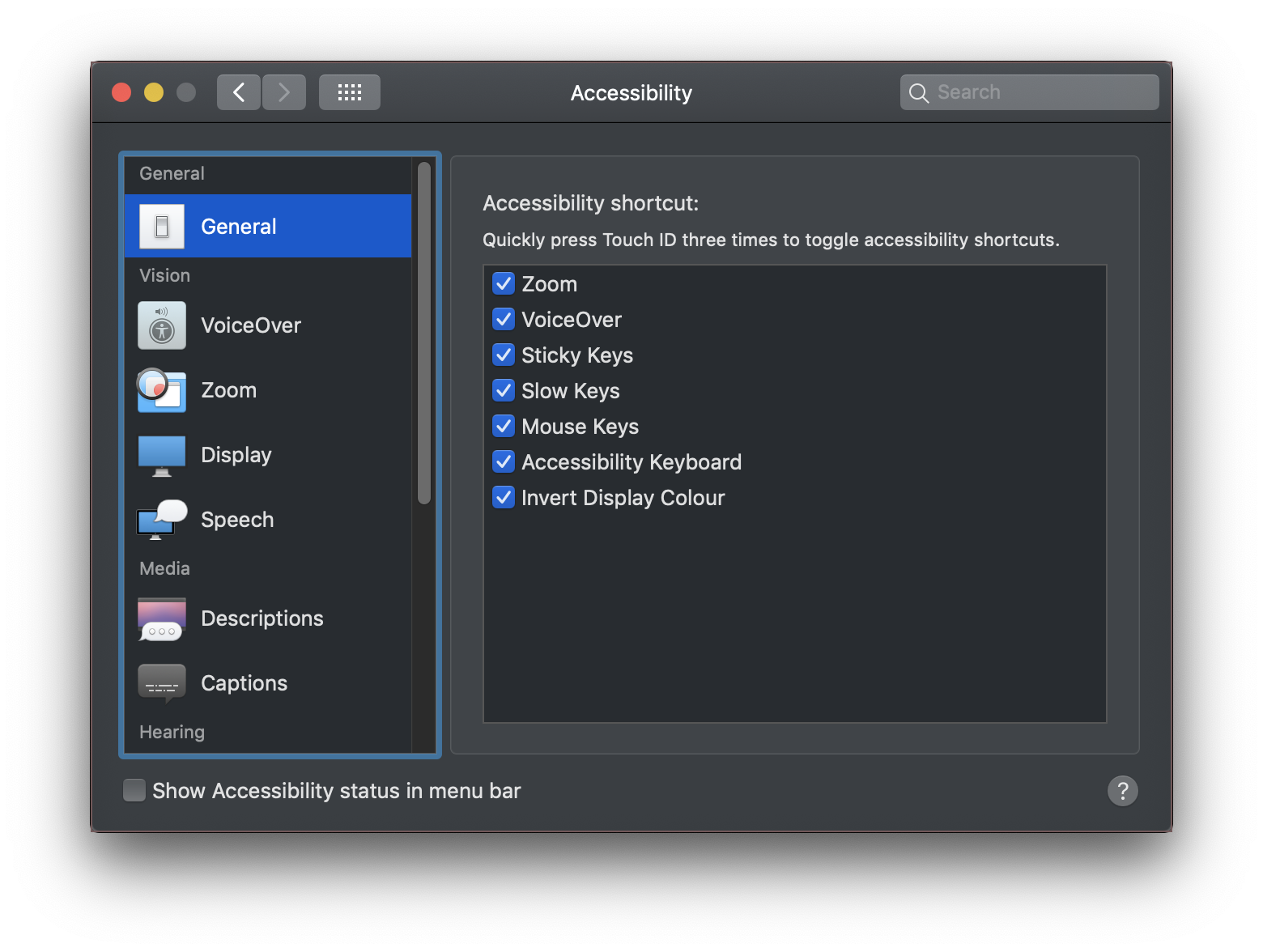
-
-
Enable keyboard shortcuts to zoom
-
in the left panel, select the
Zoomicon -
in the right panel, ensure
Use scroll gesture with modifier keys to zoomis checked, and that the modifier key is set to^ Control
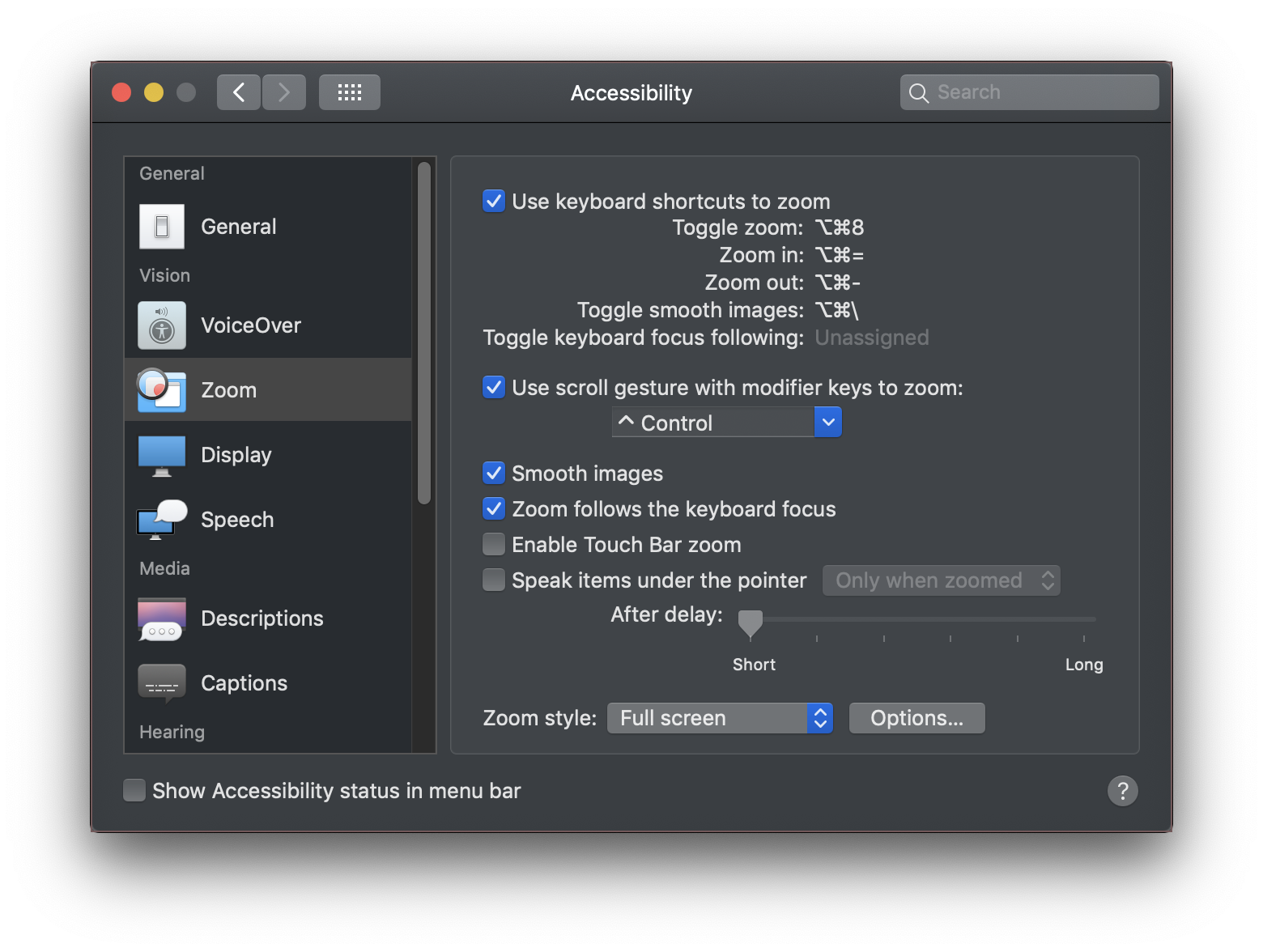
-
-
How to zoom
-
Hold down
<control>and use the scroll wheel / trackpad to zoom in / out -
Move the cursor to the edge of the screen to pan
-
For Windows
-
"Install" the ZoomIt application
-
Download ZoomIt
-
Extract the application anywhere
-
-
Ensure the zoom setting is properly configured
-
Double-click the ZoomIt executable file
-
You should see a window pop
-
If not, look for it in the taskbar notification area, right-click on the ZoomIt icon, and select
Options
-
-
Click on the
LiveZoomtab -
Ensure that a keyboard shortcut is set for the
LiveZoom Toggleoption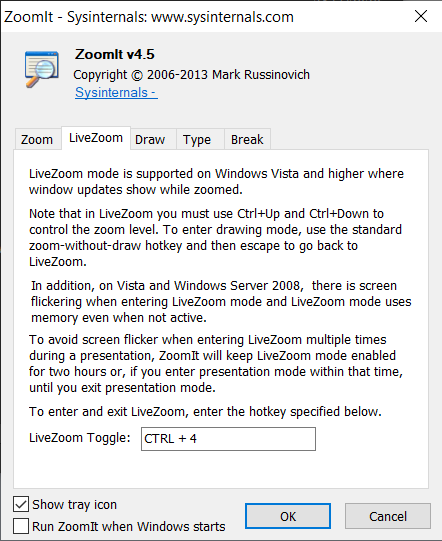
-
Close the window
-
-
How to zoom
-
Press
<control> + 4to toggle zoom -
While zoomed in, use
<Control> + <mouse wheel up / down>to change the zoom level -
Move the cursor to pan the screen
-
Tip 4 (for lols): Tmux for the Hardcore
-
Just use tmux and have your audience "remote-in" to the same session.
Tip 5: Display an Agenda List on Screen
Have visual aid to show the agenda frequently.
The nature of an online interaction is that it is much harder for the presenter to engage the audience, and it's much easier for the audience to get distracted and lose track of the where he/she is in presentation.
A simple way to keep everyone on track is to have a visual aid. It might be as simple as a plain text editor with the agenda items listed in point form, and some marker to indicate where the presenter is at:
+ Agenda Item 1
+ Agenda Sub-Item A
+ Agenda Sub-Item B
+ Agenda Sub-Item C [here]
+ Agenda Item 2
...Another benefit of having such a list is that when the presenter has nothing better to show on the screen, instead of staying on a web browser (with its distracting ads) or a code editor (where the audience might instinctively begin looking for bugs), the presenter can just show the agenda list and speak.
Tip 6: Have An Audience Take Notes
This is helpful is a discussion setting (as opposed to a presentation setting).
To ensure that messages get across, have anyone but the speaker take notes on a shared document editor (e.g., Google Docs).
This way, there is a natural pause when the presenter realises the notetaker is having problems catching up.
Yes, this will likely reduce the amount of content covered in the amount of time, but this is exactly the point—fewer but good communications trumps voluminous bad communications.